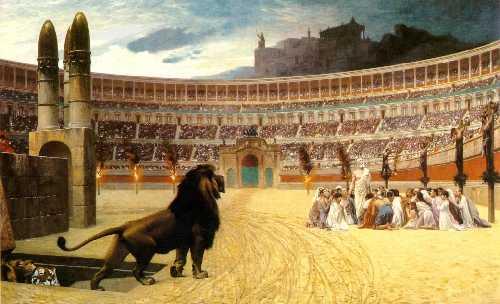The Church was born out of blood and persecution. As the traditional saying credited to Tertullian went: “The blood of the martyrs is the seed of Christians.” All of the Apostles were martyrs, including Saint John, who, although submerged into boiling oil during the persecution of Emperor Domitian, was miraculously preserved from death and bodily harm. The fact that he was willing to die for Christ (tradition has it that he also felt the pain) merited for him the martyr’s crown. All of the saints named in the canon of the Mass were martyrs, except for Our Lady, whose unique, un-bloody martyrdom was like a sword piercing her soul. The first thirty-three popes were martyrs. It was revealed to Saint Alphonsus Maria de Liguori that in the first three centuries of persecution, from the Edict of Nero (which began the persecutions) in the year 66 to the Edict of Milan (which ended them) in 313 eleven million of the faithful were martyred for their Faith in Christ. Finally, in the last days, during the reign of antichrist, the faithful will endure the worst of all persecutions, and martyrs will usher in the final triumph of the Church, which will precede the end of the world.
Truly, then, we belong to a Church of martyrs. Every age has contributed its share, some ages many more than others, but there have been martyrs at all times, some of whom are known only to God, His angels, and His saints. We have our martyrs today and we shall surely have them tomorrow.
Some of the victims of Communism who were spared the shedding of blood unto death suffered more than the martyrs, even thirty years of prison or in labor camps, under the most inhuman of conditions. In Communist China, to be a bishop loyal to the pope, guaranteed a prison sentence with at least mental torture, or death.
Why does God require so much blood from His servants? Why such a price? Why so much suffering?
Could it be that God wishes to exact from His closest disciples that greatest of all acts of love which Jesus was Himself to manifest for all men: “Greater love than this no man hath, that a man lay down his life for his friends” (John 15:13)?
At the Last Supper, in anticipation of His Passion and Death, Our Lord was very anxious to assure His Apostles that they were now His intimate friends: “I will not now call you servants: for the servant knoweth not what his lord doth. But I have called you friends: because all things whatsoever I have heard of my Father, I have made known to you” (John 15:15).
It was in His Passion and Death that Christ manifested how great was His love for men. “In this we have known the charity of God, because he hath laid down his life for us: and we ought to lay down our lives for the brethren” (1John 3:16). So, too, with the martyrs, in their passion and death they manifest how great a love they have for their Savior.
Nevertheless, many of the holiest of saints, even though they desired the crown of martyrdom, were not asked to make that sacrifice. Rather their whole lives were continual oblations of self-sacrifice. Think of Saints Francis of Assisi or Teresa of Avila. Then, there are the stigmatists, such as Saint Padre Pio, who suffered a martyrdom in his hands, feet, and side, on the cross every day, but without death, for fifty years. (Read more.)
 Happy Michaelmas Day!
Happy Michaelmas Day!





















